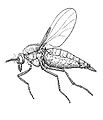Ceratopogonidae
| Ceratopogonidae Temporal range:
| |
|---|---|

| |
| A female biting midge, Culicoides sonorensis | |
| Scientific classification | |
| Domain: | Eukaryota |
| Kingdom: | Animalia |
| Phylum: | Arthropoda |
| Class: | Insecta |
| Order: | Diptera |
| Suborder: | Nematocera |
| Infraorder: | Culicomorpha |
| Superfamily: | Chironomoidea |
| Family: | Ceratopogonidae Newman, 1834 |
| Subfamilies and tribes[1] | |
| |
Ceratopogonidae is a family of flies commonly known as no-see-ums, or biting midges, generally 1–3 millimetres (1⁄16–1⁄8 in) in length. The family includes more than 5,000 species,[2] distributed worldwide, apart from the Antarctic and the Arctic.
Ceratopogonidae are
Larvae need moisture to develop, but also air and food. They are not strictly aquatic or terrestrial.[4]
Some species within the biting midges are thought to be predatory on other small insects. Particularly
Like other blood sucking flies,
Historically, numbers were managed with the insecticide DDT[4] as with Leptoconops torrens populations in California. They can be trapped by luring them with carbon dioxide. Most midges are small enough to pass through ordinary insect window screening. They can be repelled with DEET,[4] oil of Eucalyptus, or Icaridin. Their larvae have also been shown to be susceptible to treatment with commercially available preparations of Bacillus thuringiensis israelensis.[10]
Subfamilies
The Leptoconopinae is a subfamily of biting midges.[11] The larvae are recognized by their unique sclerites of the head, and by their mouthparts.
The Forcipomyiinae are a subfamily of biting midges. In this subfamily, both anterior and posterior prolegs are present on the larvae. Larvae are both terrestrial and aquatic, and feed primarily on algae and fungi. Some species are important
Larvae of species in the Dasyheleinae subfamily are characterized by an anal segment with retractile posterior prolegs. Larvae are aquatic and adults do not feed on vertebrate blood, nor do they prey on other insects. They take nectar only, an unusual feeding behavior within the Ceratopogonidae.
The Ceratopogoninae subfamily has elongated larvae without prolegs or hooks. Most larvae of this subfamily are predatory. Adults generally take vertebrate blood or attack other insects. Most females in the subfamily
The oldest known member of the family is Archiaustroconops besti from the Purbeck Group of Dorset, England, dating to the Berriasian, around 142 million years ago.[12]
Systematics
Basal lineages[13]
- †Lebanoculicoides Szadziewski 1996 Lebanese amber, Barremian, Spanish amber, Albian
- Subfamily Leptoconopinae Noe 1907
- †Archiaustroconops Szadziewski 1996 Durlston Formation, United Kingdom, Berriasian, Lebanese amber, Barremian, Jordanian amber, Spanish amber, Albian, Burmese amber, Myanmar, Cenomanian
- Austroconops Wirth and Lee 1958 Barremian-Present
- †Fossileptoconops Szadziewski 1996 Lebanese amber, Barremian
- †Jordanoconops Szadziewski 2000 Jordanian amber, Albian
- Leptoconops Skuse 1889 Barremian-Present
- †Minyohelea Borkent 1995 Austrian amber, Hauterivian Lebanese amber, Barremian, Canadian amber, Campanian
- †Archiculicoides Szadziewski 1996 Lebanese amber, Barremian
- †Gerontodacus Borkent 2019 Lebanese amber, Barremian, Spanish amber, Albian
- †Protoculicoides Boesel 1937 Burmese amber, Myanmar, Cenomanian, Canadian amber, Campanian
- †Atriculicoides Remm 1976 Spanish amber, Albian Durtal amber, France, Cenomanian, Burmese amber, Myanmar, Cenomanian, Taimyr amber, Russia, Cenomanian, Santonian
- Dasyhelea Kieffer 1913
- Subfamily Forcipomyiinae
- Atrichopogon Kieffer 1906
- Forcipomyia Meigen, 1818
- †Adelohelea Borkent 1995 Hungarian amber, Santonian, Canadian amber, Campanian
- †Heleageron Borkent 1995 New Jersey amber, Turonian Canadian amber, Campanian
- †Alautunmyia Borkent 1996 New Jersey amber, Turonian
Gallery
-
Larval stage of a ceratopogonid species
-
Atrichopogon sp. on Oedemera virescens
-
Ceratopogonid male
-
Leptoconops
-
Ceratopogonid feeds on a mantis (The midge is on the front right femorotibial joint of the mantis, the mantis is eating a bee)
-
-
Palpomyiini caught by sticky hairs of penstemon
References
- .
- ISBN 978-94-010-4679-4.
- PMID 12679068.
- ^ a b c d "common name: biting midges, no-see-ums, scientific name: Culicoides spp. (Insecta: Diptera: Ceratopogonidae)". Featured Creatures. University of Florida. Retrieved 20 September 2018.
- ^ Hribar, Lawrence J.; Mullen, Gary R. (1991). "Predation by Bezzia larvae (Diptera: Ceratopogonidae) on mosquito larvae (Diptera: Culicidae)". Entomological News. 102 (4): 183–186.
- .
- ^ ISBN 9781770851009.
- PMID 23933421.
- PMID 3908679.
- ^ "World Health Organization" (PDF). WHO.int. World Health Organization. Retrieved 1 April 2020.
- S2CID 83472814.
- ISSN 0032-3780.
- S2CID 91737913.





